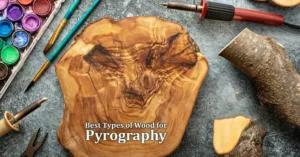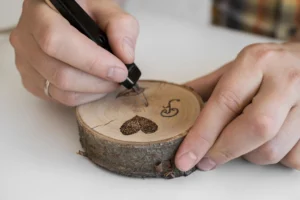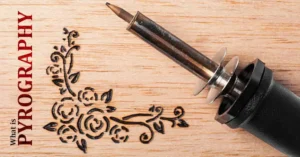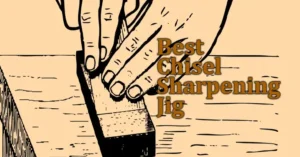When I first started working with metal, I quickly realized how important accuracy was especially when it came to cutting and fitting pieces together.
That’s when I was introduced to metal scribing tools, and I immediately understood their value.
These simple yet essential tools allow metalworkers like me to make precise marks on metal surfaces, ensuring every cut, weld, or joint fits perfectly.
If you’re new to metalworking or just looking to fine-tune your technique, this guide will walk you through what metal scribing tools are, how to use them, and why they’re crucial in creating clean, accurate marks on metal.
Table of Contents
What Are Metal Scribing Tools?
Metal scribing tools are instruments used to mark precise lines on metal surfaces.
They are designed to scratch or score a surface, leaving a visible line for guiding cutting, welding, or fitting processes.
These tools come in various forms, from traditional carbide-tipped scribes to modern mechanical versions that offer greater control and convenience.
There are several types of metal scribing tools, each with its specific use.
For example, a carbide-tipped scribe is commonly used for hard metals like steel, while a mechanical scribe can adjust to different depths, providing versatility for various projects.
Why Are Metal Scribing Tools Important?
Precision is critical when working with metal. Whether you’re cutting, bending, or welding, a slight mistake can lead to major issues in your project.
That’s where metal scribing tools shine they allow you to make accurate, clean marks that guide your work.
For instance, when I’m marking welding materials, I rely on my scribing tool to ensure that every joint line up perfectly.
Without these marks, it would be nearly impossible to make consistent, quality cuts.
How to Use Metal Scribing Tools
Using a metal scribing tool is straightforward, but it requires precision and attention to detail.
Here’s a simple step-by-step process that I follow whenever I use one:
Step 01: Position Your Material
Begin by placing your metal piece in the desired position. Ensure it’s level or parallel to the surface it will be fitted to. This ensures accuracy as you mark your measurements.
Step 02: Measure the Gap
Determine the amount of material that needs to be removed to fit the item properly. Measure the gap between the piece and the surface to understand how much trimming is necessary.
Step 03: Adjust the Tool
Set your scribing tool to the correct size by adjusting the lock nut and positioning the blade holder to match the gap measurement.
Step 04: Mark the Metal
Hold the scribing tool at a 90-degree angle to the surface and apply slight pressure to mark the metal as you move the tool back and forth.
This is where precision is crucial maintaining even pressure ensures the mark is consistent.
Step 05: Trim the Metal
Once the line is visible, you can trim the material using a jigsaw or electric planer, following the line you’ve marked for a perfect fit.
If you’re working in tight corners, like in cabinetry, you’ll need to rotate the tool slightly to scribe into the corner properly.
This method ensures accuracy even in the most complex shapes.
Common Applications of Metal Scribing Tools
Metal scribing tools are versatile and are used in various industries.
In metalworking, they’re indispensable for fabrication, welding, and sheet metal work.
Whether it’s a DIY project or professional fabrication, these tools help create precise marks that guide each step of the process.
In construction and carpentry, scribing tools also play a significant role.
For example, when installing flooring, the scribing tool is used to mark the edges of the floorboards, ensuring a snug fit against walls or uneven surfaces.
It’s one of those tools that, when used correctly, can save you a lot of time and frustration.
Choosing the Right Metal Scribing Tool
Choosing the right scribing tool depends on the material you’re working with and the type of work you’re doing.
When I first started, I made the mistake of using a low-cost, generic scribe for everything.
However, I soon realized that different metals require different tools for the best results.
For instance, a carbide-tipped scribe works best for harder metals, while a mechanical scribe is perfect for softer materials or intricate markings.
Consider your project’s precision needs and the durability of the tool when making your choice.
For beginners, I recommend a simple mechanical scribe, as it’s adjustable and easy to use.
Professionals might prefer a more specialized tool, such as a carbide-tipped scribe, for tougher materials.
Tips for Maintaining Metal Scribing Tools
Keeping your scribing tools in good condition ensures they last longer and perform well.
After frequent use, blades can become dull, affecting accuracy.
When this happens, replace the blade with a sharp one to avoid compromising your marks.
I always clean my tools after each use and store them in a dry place to prevent rust.
For tools that feature a foot pad cover, remember to remove it when not in use, as this can help prevent wear and tear.
Real-Life Examples and Benefits
I recall a time when I was working on a custom cabinet project.
The walls weren’t perfectly square, which meant the cabinet would need to be scribed to fit the space precisely.
Using a metal scribing tool, I was able to mark the areas that needed trimming and made perfect cuts, resulting in a cabinet that fit snugly into place.
Without the tool, the project would’ve been far more challenging and less precise.
The ability to make accurate marks isn’t just about aesthetic appeal it’s about functionality.
By using a metal scribing tool, I was able to reduce errors and improve the overall quality of my work.
FAQs for Metal Scribing Tools
Can I use a metal scribing tool on wood?
While metal scribing tools are designed for metal, they can sometimes be used for woodworking projects if needed. However, there are specific scribing tools made for wood, which would give you better precision.
How do I replace the blade on a scribing tool?
To replace the blade, simply unscrew the lock nut, remove the dull blade, and rotate it to an unused sharp point. Be sure to tighten the screw properly, but don’t overtighten it.
Can I use a scribing tool for cutting metal?
A scribing tool is not designed for cutting metal. It is for marking the metal, which helps guide accurate cuts with tools like a jigsaw or an electric planer.
What are the best metal scribing tools?
Some of the best metal scribing tools include carbide-tipped scribes, adjustable sheet metal scribe tools, and metal scribe pens. Look for durability and precision when choosing the best tool for your needs.
What is an adjustable sheet metal scribe tool?
An adjustable sheet metal scribe tool allows you to change the width and depth of your marking line, making it ideal for metalworking projects that require accurate, customizable markings.
Is there a metal scribe tool at Harbor Freight?
Yes, Harbor Freight offers a variety of metal scribe tools for different applications, including scribe pens and carbide-tipped scribes for marking metal, steel, and other hard surfaces.
What is a metal scribe pen?
A metal scribe pen is a compact tool designed for marking on metal surfaces. It’s ideal for creating fine, precise lines when cutting or drilling.
How does a metal scribe compass work?
A metal scribe compass is used for drawing arcs and circles on metal surfaces. It features adjustable arms to customize the radius of the circle, perfect for detailed marking.
What is a scribe marking tool used for?
A scribe marking tool is used to make precise marks or scores on hard surfaces like metal, wood, and plastic. It’s essential for accurate measurements before cutting, shaping, or drilling.
Conclusion
Metal scribing tools may seem simple, but they are invaluable in ensuring accuracy and precision in metalworking and other trades.
Whether you’re a beginner or a seasoned professional, having the right scribing tool for your projects can make a world of difference.
I encourage you to explore different tools, experiment with them, and see how they can improve your work.
Trust me once you get the hang of it, you’ll never look back.
For more information on scribing tools, check out my other posts on:
- 5 Best Carpenters Scribing tool for Easy and Precise Marking
- Choose the Best Scribing Tool for Marking the Measurement of Your Job
- Scribe Molding: Improve the Look and Performance of Cabinets
- 5 Best Mechanical Carpenter Pencils for Accuracy Measurement
- Complete Guide to Scribing Tools: 7 Types and Uses for Precision Marking
By Hasan.







